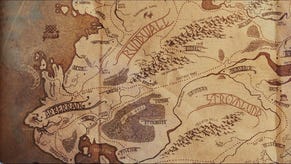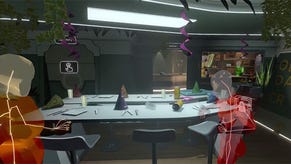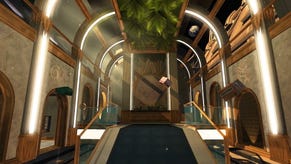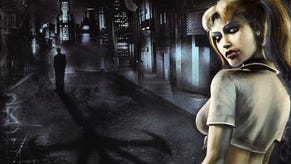Steve Gaynor On The Weirdness Of Gone Home
“The coolest new cordless phone!”
There's a weird tension to Gone Home. On the one hand it should be the most normal thing in the world: an American household. On the other, well, it's unusual for games to try and tell stories about everyday lives. But that's precisely what it does, and that's just part of what makes it so beautifully weird.
I met Fullbright's project lead, Steve Gaynor, and talked about that. This is how we got on.
RPS: Mr Gaynor, we meet in a scenario that is not actually Twitter?
Gaynor: Yeah! And a lot of good stuff came out of being active on Twitter, like our environment artist, Kate, we found her through Twitter, because Emily Caroll - she's a really great comic artist, she did amazing fan art in a really distinctive style – and so I followed her and then met her at a convention, and it turns out she's married to Kate, who says “oh hey I am a videogame environment artist!” and yeah what is that what we needed. She has the exact right mindset, and was on the exact wavelength for this game. It was just through seeing people's art on twitter and liking that and following them. There are just a lot of really smart people talking about videogames on Twitter.

RPS: So let's talk Gone Home itself – I am sure you've talked a bunch about this sort of stuff already, but can you tell me a bit about how you came to be making it?
Gaynor: Karla, Johnnemann and I were the three people that formed the company, and we had previously all worked on Minerva's Den together. I left and worked on Infinite for a year, and they stayed and worked on the Xcom shooter for a year, and it was kind of this arc of big projects, very small projects – Minerva's Den was like twelve people – and then back to big projects, and we felt like we wanted to get back to that small team feeling, where everyone felt invested in the entirety of the project. So after I had been in Boston for a year, my wife and I decided that we wanted to move back to Portland – she is from there and I had lived there for a time – but there's not really an established games industry there. So I convinced Karla and Johnnemann to come up and do our own thing. We had experience in first-person, immersive games that featured non-linear exploration, and discovering the story in the environment, plus shooting mutants and collecting loot! As a group, we are mostly inspired by the player-driven exploration aspect, where you discover the story yourself and piece it together from clues in the environment. Usually that's a sideshow in games, but we thought it could be the game. We knew that to work it had to be small in scope, so it one house, not in an entire city or something. And we felt we could make it with four people.
RPS: Are you aware of how odd that feels to the player? It has a similar sort of atmosphere to a classic adventure game, while having the tactility of a shooter without actually shooting anything... I guess it defies expectations. It sits in a new place on the big Venn diagram of game genre overlaps.
Gaynor: I definitely feel that we have made a weird game. It's weird differently than a lot of weird games. So you play Bioshock and you are in an undersea city battling a giant diving suit man. It's the opposite kind of weird. It's so normal that it's weird to be playing a videogame of it. I had that moment of clarity when I was walking around and I was walking through one of the parents bedroom and one of the diary entries was playing, talking about going to see a band, and I remember thinking “this is one of the weirdest experiences I've had in a videogame,” because it's SO non-weird. But as far as the feel of playing goes, I think the tactility and the consistency of visual language comes from our background in trying to create immersive first-person games. It wants to say that you can do whatever you could do in that environment as if you were really there. So if there's a drawer you can open it, and if there's a door you can see behind it, and if it's locked you can find the key for it, and if something is not nailed down you can pick it up. I think one of the other important things about immersive sims is that they are not about virtual reality, they are about what the character would do. So in Thief you can steal stuff because that's what Garrett would do, but you only steal valuable stuff, because he would not take the wooden plates or whatever. It was important for us to say “you play as a member of this family, so you behave as you would as a part of that”, but at the same time they've moved into this house while you were away, so you don't know your way around already. You're not just tearing all the pictures off the wall and smashing stuff, because that's not what someone in this situation would do.
RPS: Yeah, that's a real moment of clarity in this game in that regard. It's like... in Half-Life 2 there's a moment at the start where the guard makes you put a can in the waste bin, and so you realise it's going to be about physics manipulations. And playing Gone Home, I picked something up, examined it, and then I put it back. And I did that within the physics. It wasn't the classic game thing where you are Mr Magoo and everything is there to be knocked over with no way to tidy it up. There's a normal behavioural response, in life you don't examine something and then destroy it or put it in your inventory. You put it back on the shelf.
Gaynor: We had a very early playtest where people said to us: “I felt like I was in a house, and I wanted to be careful, be respectful of the environment.” They would pick up a family photo and then try to put it back, but it would fall on the floor or whatever. So you feel clumsy, but you also just feel like you are being an asshole. It was important to us that we come up with a system that didn't say that you have to put something back where it goes, but let the player express than intent, voluntarily. Because you can still take a photo and throw it on the floor, but I think most people want to treat the world a little less recklessly.
RPS: It's an interestingly slight change of context. A family home that you are returning too, rather than a family home that you have busted down the door of because you are part of a SWAT team.
Gaynor: Or the apartments at the beginning of Half-Life 2, where the rebels are hiding out – you can pick up the TV and throw it out of the window, and there's a very different feel to a place when it distinctly belongs to individuals.
RPS: Can you talk a bit about the Nineties theme? As you've talked more about the game, and having played it a bit, I can see you've been very particular about setting it at that time. The pre-cellphone era when I watched a lot of X-Files... Why is it that?
Gaynor: None of our creative decisions are purely answering “What's the setting?” “What's the story?” You ask “what does the player do?” regardless of the fictional setting. Discovering the story in the environment is what is important, and then that starts a whole series of problem-solving, and some of that comes down what we can build with four people. So maybe one house that is really densely packed with stuff to find, and we go from there. We want it to be familiar and believable, not something that is set in the 19th century, but if you set it in 2013, then you just go and find someone's email login and there's the whole story right there. Nobody is leaving notes for each other in 2013, because text messages... but for the game what was interesting was exploring the environment. So 1995 was as little as we could turn the clock back to where they don't have AOL and we can have written letters to find in a draw. When you come to that decision you have to sign up to it completely. You have to make people believe that there are in that context.
RPS: How much of the content in the house is content from your real lives from that point in time?
Gaynor: All of the photos of the family in the house are actually photo paint-overs of my wife's family, because she has a sister who is two years younger than her, and she's our age, so she was at high-school in the Nineties. So that's a literal source. But we also went back and watched a lot of media from the Nineties. We went back and watched My So Called Life on Netflix, and so uh Sassy magazine, which was really feminist and forward looking, and that helped us form the character's outlook and interests. There was a lot of looking at furniture and fashion, too: “The coolest new cordless phone!” A reminder that this was before the stuff that defines now.
RPS: Can you tell me about the Nineties soundtrack?
Gaynor: The core of the story is about Samantha, who is a teenager, and part of her experience is meeting a friend who is way cooler than her, who introduces her to music she has never heard before. We needed something that did that, so we looked to this sort of lo-fi music that came from the Pacific north west, something that was local and would have appealed to the kind of characters we're talking about in the game. It would, we knew, say a lot about their experiences just by being able to hear it. Lucky for us all the bands we wanted were with a label in Portland, so we got in touch with their agency and we now have six tracks from two bands, and like the rest of the stuff that followed the decisions we had made to a logical conclusion. We're really happy that it worked out. And, again, not many games really take place in the Real World for real, but this does, and while we have some fictional supermarket brands in our game, the music of the time says a lot.
RPS: it sure does. And I am going to be fascinated to see what the full story behind Samantha's solitary house explorations actually is... Thanks for your time.
Gone Home will get a PC, Mac and Linux release in 2013.









